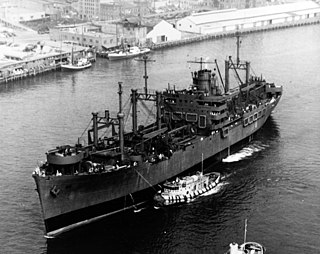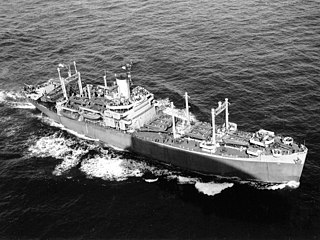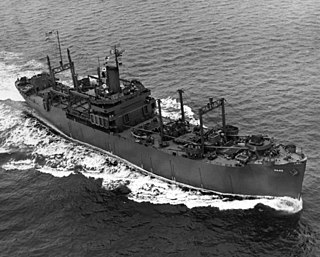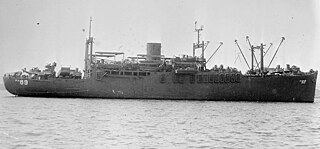
USS Fuller (AP-14/APA-7) was a Heywood-class attack transport in service with the United States Navy from 1941 to 1946. She was scrapped in 1957.

USS Sumter (APA-52) was a Sumter-class attack transport that served with the United States Navy from 1943 to 1946. She was subsequently sold into commercial service and was scrapped in 1978.

USS Highlands (APA-119) was a Haskell-class attack transport built and used by the US Navy in World War II. She was a Victory ship design, VC2-S-AP5. She was named after Highlands County, Florida, United States.

USS Bolivar (APA-34) was a Bayfield-class attack transport in service with the United States Navy from 1943 to 1946. She was then sold into commercial service and was scrapped in 1973.

USS Doyen (APA-1) was a Doyen-class attack transport in service with the United States Navy from 1943 to 1946. She was scrapped in 1973.

USS Cavalier (AP-82/APA-37) was a Bayfield-class attack transport in the United States Navy. She was named for Cavalier County, North Dakota.

USS DuPage (AP-86/APA-41) was a Bayfield-class attack transport in service with the United States Navy from 1943 to 1946. She was then sold into commercial service and was scrapped in 1973.

USS Heywood (APA-6) was a Heywood-class attack transport acquired by the U.S. Navy for service as a troop carrier during World War II. She served in the Pacific War, a very dangerous area in the early years of the war, and safely returned home post-war with seven battle stars to her credit.

USS Harry Lee (APA-10) was a Harry Lee-class attack transport that saw service with the US Navy during World War II. She served in the Pacific War, as well as in North Atlantic Ocean operations, and safely returned home post-war with seven battle stars to her credit. She was the only ship in her class.

USS James O'Hara (APA-90) was a Frederick Funston-class attack transport that served with the US Navy during World War II and later in the Korean War. The ship was named after a Continental Army officer who fought in the Revolutionary War and who later became Quartermaster General of the US Army.

USS Callaway (APA-35) was a Bayfield-class attack transport that served with the US Navy, and was manned by the United States Coast Guard during World War II.

USS Custer (AP-85/APA-40) was a Bayfield-class attack transport in service with the United States Navy from 1943 to 1946. She was sold into commercial service in 1948 and was scrapped in 1973.

USS Fayette (APA-43) was a Bayfield-class attack transport that served with the United States Navy from 1943 to 1946. In 1947, she was sold into commercial service, where she served as SS Robin Gray until being scrapped in 1972.

USS Fremont (APA-44) was a Bayfield-class attack transport that served with the US Navy during World War II.

USS Knox (APA-46) was a Bayfield-class attack transport in service with the United States Navy from 1944 to 1946. in 1947, she was sold into commercial service and was finally scrapped in 1971.

USS Audrain (APA-59) was a Gilliam-class attack transport that served with the US Navy during World War II.

USS Frederick Funston (APA-89) was a Frederick Funston-class attack transport that served with the US Navy during World War II. Before serving as a Navy APA, she had been the US Army transport USAT Frederick Funston. After World War II, she was returned to the Army and operated as USAT Frederick Funston. Funston was among the seventy-two ships transferred to the Navy's Military Sea Transportation Service (MSTS) in the 1 March 1950 group and placed in service as USNS Frederick Funston (T-AP-178).

USS Ormsby (APA-49) was an Ormsby-class attack transport that served with the US Navy from 1943 to 1946. She was subsequently sold into commercial service and was scrapped in 1969.

USS Sheridan (APA-51) was an Ormsby-class attack transport that served with the US Navy during World War II.

USS President Adams (AP-38/APA-19) was a President Jackson-class attack transport of the United States Navy, named for Founding Father John Adams and his son, John Quincy Adams, the second and sixth Presidents of the United States.




















